Comment March 19, 2018
Four Major Non-Scientific Moments in IISD-ELA History: Mother Nature makes her mark
By Chandra Rodgers, Fisheries Research Biologist
Now that we are celebrating the 50th anniversary of the world’s freshwater laboratory, we have taken some time to look back on some of the great moments in IISD Experimental Lakes Area history.
These are not great moments in the history of our freshwater science per se (although there have been plenty of those), but key moments when Mother Nature has decided to step in to alter the course of IISD-ELA history.
1973: The Great Windstorm
On July 7, 1973, about 50 mature jack pine trees snapped off their hinges and plummeted to the ground around our camp after a fierce overnight windstorm. Most of the trees fell in the forest, but a few of the buildings (and cars) took some of the hits, as you can see from the photos below.
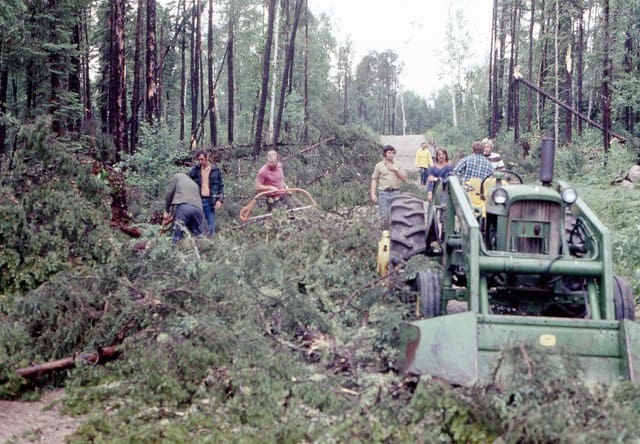
As a result of the Great Windstorm of 1973, most of the trees fell in the forest, but a few of the buildings (and cars) took some of the hits.
Residents later found out that a powerful cyclonic system had developed in the early morning somewhere over Lake of the Woods and had moved northeastward toward Dryden (through the Experimental Lakes Area) before dying out. The wreckage seen here shows some of the damage, but thankfully, most of the buildings and vehicles made it through the storm unharmed.

Some of the cars were hit by the felled trees during the Great Windstorm of 1973.
1980: The Great Forest Fire
There have been many forest fires around the site over the years. One of the most notable, and certainly the closest to the main camp, was a forest fire we experienced on Friday, June 20, 1980.
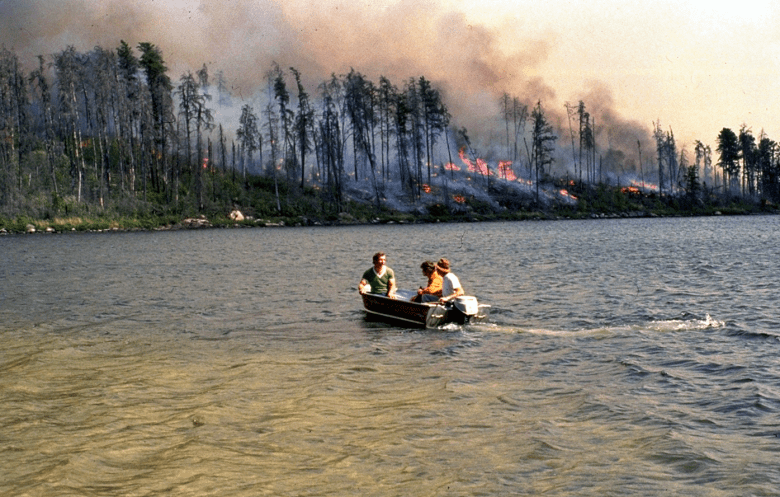
Dave Schindler, John Shearer and a firefighter from the Ministry of Natural Resources and Forestry head towards the east shore of Lake 240. The fire can be seen in the distance.
The fire began close to Lake 240 in the morning and moved up the shoreline towards camp by the afternoon. (For those of you who have visited the Experimental Lakes Area, Lake 240 is directly adjacent to camp, with its iconic treed island straight out from the swimming beach and fire pit.)
The camp was soon evacuated and only a few remained in camp. Some staff members at the time remember leaving camp, trying to save as much data and equipment as they could fit in their cars. Many remember leaving thinking they may never see the camp the same way again. They returned later to find a thin green patch surrounding the ELA camp and found that the fire had swung around either side of it.
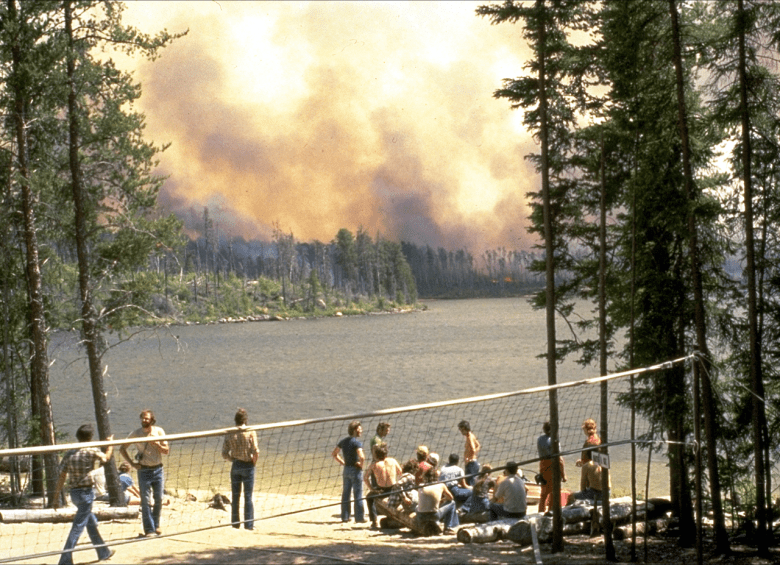
ELA students and staff watch the Great Forest Fire of 1980 as it proceeds towards the camp.
The firefighters did a phenomenal job keeping ELA safe. A fire line was installed around the ELA camp soon after in May 1981. This fire led to many physical and chemical catchment changes, evident within the long-term monitoring dataset, which influenced much scientific literature.
2007: The Great Road Washout
In August 2007, a culvert near Pine Road (the road that connects IISD-ELA to Hwy 17) rusted and collapsed just south of Lake 442—one of our reference lakes. This resulted in a slow increase in water levels within the lake and eventually, a powerful overflow of water at the lower road crossing nearby. As the overflow continued, it eroded the gravel and dirt, making the gap in the road wider and wider with time.

A tremendous amount of organization and teamwork was needed to transport all of the researchers down camp road, while also completing the regular fieldwork.
The road quickly became impassable by car, and researchers itching to do their science could not get to camp. The camp manager, along with many students and staff, rushed out to the road to help build a walking bridge across the washout. Researchers and students coming into camp drove in as far as they could, parked at the north side of the washout, walked across the impromptu bridge and then caught a shuttle the remainder of the way to camp.
A tremendous amount of organization and teamwork were needed to transport all of the researchers down camp road, while also completing the regular fieldwork! It took a week before the flow of water calmed and the washout could be re-filled with gravel and dirt.
2017: The Great Snowstorm
The most recent major storm at IISD-ELA took place only last fall!
On October 26, 2017, we were hit with 37.5 mm of rain and snow and up to 55.25 km/hr winds—a combination that made for a perfect storm. Heavy, wet snow piled on trees that sent majestic cracks and crashes echoing through the forest. There were about 20 people at the camp at the time, all ready to help clear the road and the trails once the storm finished.
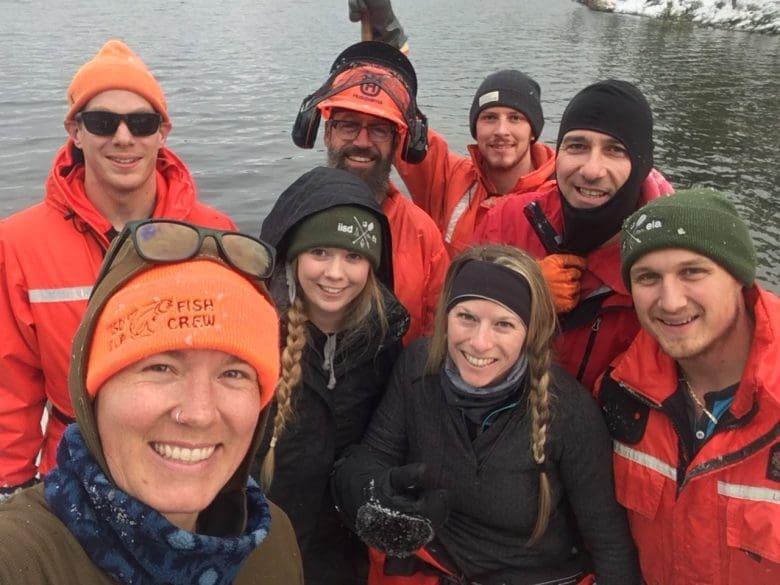
A heroic effort was made by all of our staff and students to restore the roads and trails to their original condition, after the Great Snowstorm of 2017.
We cleared the 30 km camp road in two days with the use of a backhoe, chainsaws, clippers and a lot of muscle-power. The main trails took several more weeks to clear, and some have yet to be conquered, but a heroic effort was made by all of our staff and students to restore the roads and trails to their original condition.
You can read more about the Great Snowstorm of 2017 here.
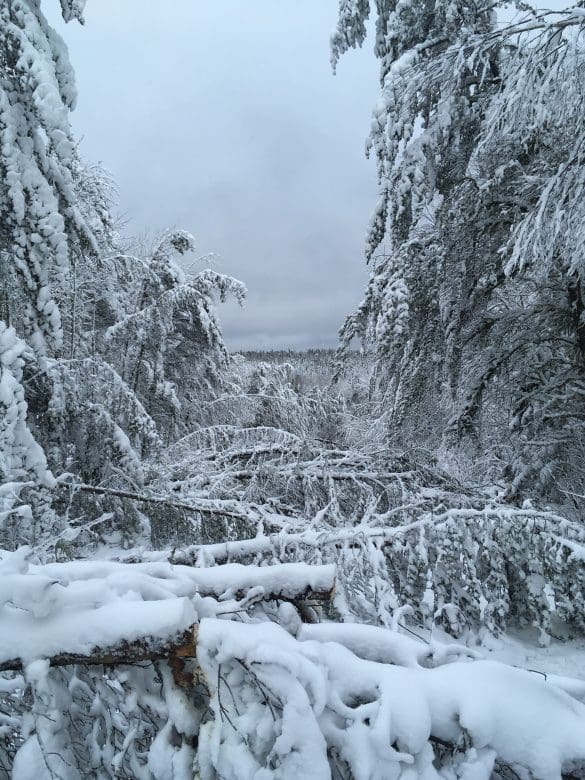
The most recent major storm at IISD-ELA took place only last fall.